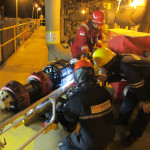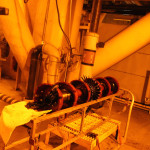Inline Inspection Operation Executed by T.D. Williamson
Inspecting and maintaining sub-surface pipelines is always challenging. When the pipelines are located offshore in turbulent seas, the challenge increases exponentially. When the operation is carried out in the dead of winter in subzero temperatures, the task qualifies as, well, heroic.
Every operator understands the need to maintain a pipeline network to the most rigorous standards of productivity and safety. This need demands regular inspections using state-of-the-art methods to generate a comprehensive picture of the condition of the line. The more complex and isolated the pipeline network, the more complicated the task becomes.
In the Bohai Sea, 375km southeast of Beijing, a lattice of pipelines stretching a total of 21.4km connects six platforms. To ensure that inline inspection of these lines was executed efficiently, while generating the greatest amount of useful data, a major operator called upon global pipeline service provider T.D. Williamson (TDW). The objective was to locate and identify threats to pipeline integrity.
Challenging, complicated and cold
The challenge of this subsea inspection operation was increased because it commenced in November when weather in the Bohai Sea is not accommodating. It was cold on the platforms, with temperatures dropping as low as -17°C.
The operation – which included pre-cleaning, deformation inspection, and magnetic flux leakage for corrosion detection – consisted of five separate pipelines, varying in diameter: 8-inch, 12-inch and 16-inch. The lines also varied in length, from 2.11 to 9.10km. Three of the lines necessitated Light Geometry Tool (LGT) and Gas Magnetic Flux Leakage (GMFL) runs, while the other two required only GMFL. In most cases, the runs were completed within one week, meeting the operator’s need for minimal downtime. Upon completion, tools were mobilized to the other platforms for additional runs. Pressure in the lines was maintained at a steady level between 81 and 88 bar (1180 and 1275 ps)i.
Despite the difficulties and dangers of the surrounding environment, all work was completed without incident and within five months.
All data was validated and analysed before being forwarded to the operator for review and assessment. By relying on TDW inspection technology to collect a wide range of dependable, in-depth data, as well as expert analysis of that data, the customer was then able to assess the condition of each line, confident that they had the information necessary to formulate appropriate maintenance plans. The operator’s proactive approach to pipeline integrity continues to ensure the extended life and productivity of its assets.








